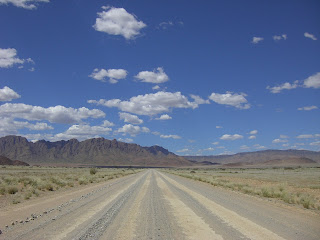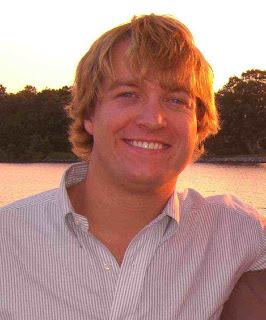We spent the final morning in Maun, Botswana frantically calling around car rental agencies in Windhoek, Namibia. With less than 12 hours to go before we were supposed to land in Namibia, it dawned on me that we didn't have a tent and hadn't rented a car. Since it was Easter weekend, many of the car rental agencies did not have a single vehicle available. With 30 minutes to go before the flight, we confirmed a rental for what seemed like the only car available in Windhoek - fortunately it had everything we wanted.

We arrived in Namibia and went through our usual routine for the first hour in a new country:
- Deplane
- Gather luggage
- Clear customs
- Estimate daily expenses (in local currency) from guide book
- Determine the exchange rate
- Complain about the US Dollar (Not applicable in Vietnam, Namibia or South Africa)
- Withdraw two to three days worth of money from an ATM
- Buy new SIM card and local number for mobile phone
The next morning we woke up early, checked out and drove to a grocery store. Driving in traffic turned out to be another adventure and one that required a great deal of teamwork at first. We stocked up our car refrigerator with enough food for the next three days and headed off to Sossusvlei.


The trip was not wasted though, because along the way we saw ostriches, meerkats, and our first springbok. We arrived just in time to catch a spectacular sunset that faded into a lingering golden glow on the horizon.
 We woke up early the next morning to avoid the midday heat and hopefully see some early morning shadows on the sand dunes at Sossusvlei. Along the hour drive back to Sesriem, we enjoyed watching sunrise over the desert while the moon was still up.
We woke up early the next morning to avoid the midday heat and hopefully see some early morning shadows on the sand dunes at Sossusvlei. Along the hour drive back to Sesriem, we enjoyed watching sunrise over the desert while the moon was still up.
Since Sossusvlei is approximately in the middle of nowhere, the park gates are located 63 kilometers away in the nearest town, Sesriem. (most westerners would confuse the "town" of Sesriem with a gas station next to a campground) Along the way we stopped at every sand dune as they got progressively larger.

Sossusvlei is not actually a sand dune, which is what the park is famous for, but is a dried clay pan among sand dunes. Although Sossusvlei is the best known pan, nearby Dead Vlei is more impressive. The brilliant white clay is surrounded by impossibly red dunes rising nearly one thousand feet out of the pan.

Ellie and I climbed up one of the smaller side dunes and took in the large dune next to Dead Vlei (pictured above). At this point we were already a few hundred feet above the pan and I stubbornly insisted on climbing the big dune.
 Pictured above: the final leg along the top ridge
Pictured above: the final leg along the top ridge The sun-scarred, black remains of a 900 year old forest punctuate the white pan.
The sun-scarred, black remains of a 900 year old forest punctuate the white pan. There is a surprising amount of living shrubbery for the middle of the desert, although most of the trees are dried up skeletons.
There is a surprising amount of living shrubbery for the middle of the desert, although most of the trees are dried up skeletons.
We quickly burned through the 2 liters of water we brought and were relieved to chug cold water back at the car. The last kilometer walk through the desert was particularly painful as scorching sand poured through the holes in my Crocs. After lunch we were feeling refreshed and decided to drive on to Swakopmund rather than staying near Sesriem again.

The first two hours of the drive were backtracking through the same hills as the day before until we reached a town called Solitaire. The town has a gas station, a hotel and a campground, which by my estimates makes it about 50% larger than Sesriem. The next hour and a half of the drive was flat plains with intermittent wild grasses, rocky outcroppings and sharp drop offs into deep canyons. Unfortunately the only interesting thing we saw for the three hours after that was a sign for the Tropic of Capricorn, the line marking the furthest point south where the sun is directly overhead at noon. As you can see from the photo below, the remaining drive to the ocean was flat and almost entirely unremarkable. We reached the Atlantic ocean at Walvis Bay after dark and drove north to Swakopmund along the coast for the last half hour. Although we couldn't see anything, the cool salty breeze was a refreshing change from the dry desert air.

We got in late and set up our car tent as quietly as possible before falling fast asleep. Swakopmund is a large town (by Namibian standards) on the Atlantic coast with a thriving adventure sports industry. The next morning we woke up early to go sandboarding.

Sandboarding was fun but difficult, I wound up with a face full of sand on many occasions. Apparently sandboarding is an easy transition from snowboarding, although its not at all similar to skiing.


The next morning was one of the rare occasions when Ellie and I split up. She went on a boat tour to see seals, but I wanted to go quadbiking in the desert.

I spent the morning driving straight up and down the dunes and feeling like the bike was about to flip over the whole time. The experience was certainly less educational than Ellie's but much more adrenalin filled.

Afterwards, Ellie and I met up with Jesse, Van, and Ryan, three Americans we'd met sandboarding, and drove back to Windhoek. We were very happy to have a break from each other and the three CDs we'd managed to borrow from the rental agency.

That evening we had dinner with our American friends at Joes Beer House, a local restaurant known for its wild game menu. Ellie and I managed to sample many of the animals we'd recently seen on safari, including ostrich, crocodile, zebra, kudu, oryx (eland), and springbok. My favorite of those was zebra, which tastes like a meaty venison.

Finally, I thought I should share two of my favorite signs from Namibia. The first is self explanatory.




1 comment:
i've always wanted to sandboard, nice air on that jump.
- bob
Post a Comment